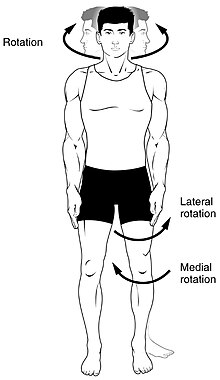Rotation (medicine)
Rotation is understood to be a turning movement around a center of rotation; in medicine , rotation is the rotational movement of the arm , leg or spine . In comparison to torsion, rotation is not a static state, but a dynamic process.
In the case of arms and legs, a distinction is made between external and internal rotation. In the case of the foot and hand , the rotation is made up of other individual movements and is then referred to as supination or pronation .
Rotation of the upper body
The rotation of the upper body takes place mainly in the thoracic spine (BWS). Due to the position of the articular surfaces of the vertebral joints in the lumbar spine, the possibility of rotation is very limited here. However, the ability to rotate increases when the upper body is leaning forward.
Rotation of the leg
Rotations are possible to a large extent in the hip joint . A distinction is made between internal and external rotation.
The lower leg can also rotate. However, this is only possible with a flexed ( flexed ) knee joint . In the flexed state, the collateral ligaments of the knee joint are slack and allow this movement. When the knee is stretched ( extended ), however , the ligaments are tense and make movement impossible. The range of motion for rotation with the knee bent is about 10 ° for internal rotation and 30–40 ° for external rotation.
The ability to rotate the leg is important when walking. The pelvis rotates around the longitudinal axis of the body. On the side of the swing leg , the pelvis rotates forwards, while on the side of the supporting leg it moves backwards. This rotation changes with the heel strike . The pelvis now rotates in the other direction. These rotations take place with the foot of the supporting leg fixed on the floor. The pelvis rotates relative to the foot. These rotational movements are made possible by the joint chain of the leg consisting of the hip joint, knee joint and ankle joint . If one of the joints falls e.g. B. removed by amputation or joint stiffening , the other joints of the chain must compensate for this loss. This can lead to damage. If the hip joint is stiffened, the knee joint is exposed to greater rotational movements, which place greater stress on the collateral ligaments and thus lead to a loose knee.
